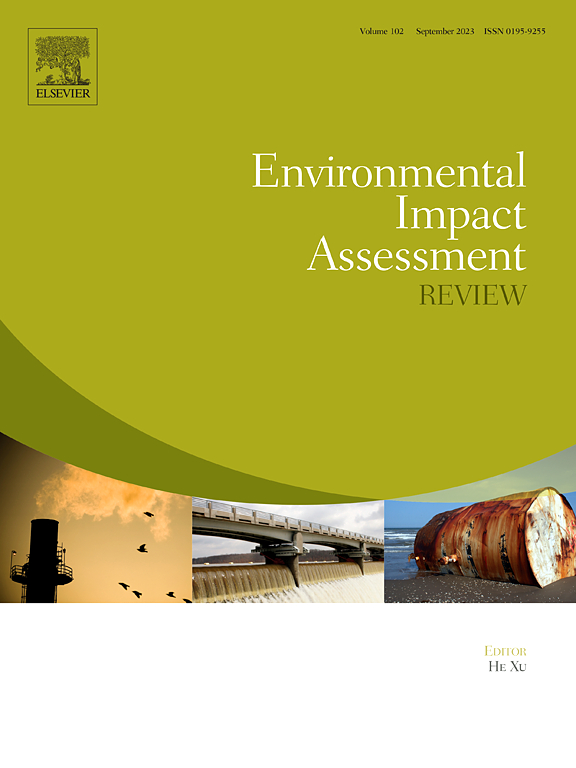碳-污染-生态的协同——协同减少污染和碳排放的未来
IF 11.2
1区 社会学
Q1 ENVIRONMENTAL STUDIES
引用次数: 0
摘要
在全球气候变化和环境污染加剧的背景下,污染与碳排放协同减排已成为环境治理和政策制定的关键焦点。将生态系统服务纳入这一框架提供了一种有希望的方法,可以同时提高生态系统质量,改善人类福祉,实现改善环境质量和减缓气候变化的双重目标。然而,目前的研究和实际应用在很大程度上忽视了SRPCE战略中生态系统服务的协同维度。本文以黄河和海河流域为研究对象,通过构建碳污染-生态协同指数(CPESI),探讨了区域污染物、碳排放和生态系统服务之间的空间协同效应。我们的研究结果表明,在实现污染减少、碳减排和生态系统服务维持等相互交织的目标方面,主要受土地利用变化的驱动,存在显著的空间异质性。CPESI结果显示,只有4.1%的地区实现了生态系统服务、污染碳排放控制的三重协同增强。双协同、双协同、三协同的面积比例分别为89.6%、5.9%、0.4%。同时,19.82%的区域呈现出污染减排与碳排放并存的“双协同”模式,凸显了当前治理中对生态服务价值评估的系统性忽视。本研究通过系统量化污染物和碳减排与生态系统服务增强之间的协同效益,建立了有效整合环境和生态目标的综合评价方法,为优化跨区域生态环境治理政策提供了有价值的决策支持工具。本文章由计算机程序翻译,如有差异,请以英文原文为准。
Synergy of carbon - pollution - ecology ——The future of synergetic reduction of pollution and carbon emissions
Against the backdrop of intensifying global climate change and environmental pollution, the synergetic reduction of pollution and carbon emissions (SRPCE) has become a pivotal focus in environmental governance and policy-making. The integration of ecosystem services into this framework offers a promising approach to simultaneously enhance ecosystem quality, improve human well-being, and achieve dual objectives of environmental quality improvement and climate change mitigation. Nevertheless, current research and practical applications have largely neglected the collaborative dimension of ecosystem services in SRPCE strategies. This study, focusing on the Yellow River Basin and Haihe River Basin, investigates the spatial synergies among regional pollutants, carbon emissions, and ecosystem services through the development of a novel Carbon-Pollution-Ecology Synergy Index (CPESI). Our findings demonstrate substantial spatial heterogeneity in achieving the intertwined goals of pollution reduction, carbon mitigation, and ecosystem service maintenance, primarily driven by land use changes. Based on the analysis of CPESI results, only 4.1 % of areas achieve triple synergistic enhancement in ecosystem services, pollution carbon emission control. The area proportions of Double synergistic increased, Double synergistic descended, and Triple synergistic descended are 89.6 %, 5.9 %, and 0.4 %. Meanwhile,19.82 % of regions demonstrate a “dual synergy” pattern where pollution reduction coexists with carbon emission, highlighting systemic neglect of ecological service valuation in current governance. Through systematic quantification of the synergistic benefits between emission reduction (both pollutants and carbon) and ecosystem service enhancement, this research develops a comprehensive assessment methodology that effectively integrates environmental and ecological objectives, which serves as a valuable decision-support tool for optimization of cross-regional ecological and environmental governance policies.
求助全文
通过发布文献求助,成功后即可免费获取论文全文。
去求助
来源期刊

Environmental Impact Assessment Review
ENVIRONMENTAL STUDIES-
CiteScore
12.60
自引率
10.10%
发文量
200
审稿时长
33 days
期刊介绍:
Environmental Impact Assessment Review is an interdisciplinary journal that serves a global audience of practitioners, policymakers, and academics involved in assessing the environmental impact of policies, projects, processes, and products. The journal focuses on innovative theory and practice in environmental impact assessment (EIA). Papers are expected to present innovative ideas, be topical, and coherent. The journal emphasizes concepts, methods, techniques, approaches, and systems related to EIA theory and practice.
 求助内容:
求助内容: 应助结果提醒方式:
应助结果提醒方式:


